Synthesis of Super-Long Carbon Nanotubes from Cellulosic Biomass under Microwave Radiation
Abstract
1. Introduction
2. Materials and Methods
2.1. Materials
2.2. Microwave-Induced Synthesis of SL-CNTs
2.3. Characterization of Carbon Nanotubes
3. Results and Discussion
3.1. Morphology and Microstructure of Carbon Nanotubes
3.2. Crystalline Structure of CNTs
3.3. Changes in the Carbon Order of CNTs
3.4. Mechanism of Formation of SL-CNTs
- I.
- The CNTs formed at low temperature act as templates for the growth of the SL-CNTs. The tip of the CNT is known to be very reactive [54]. The volatiles released from the biochar at high-temperature form PAH, which, in turn, adds graphene layers to the CNT tips, leading to the growth of the SL-CNTs. This agrees with the TEM results, which revealed an increase in the diameter after high-temperature treatment.
- II.
- Through active sites in the char, which were activated by minerals or metals during high-temperature treatment. Char can be catalyzed by a trace amount of minerals that originate from the biomass. The minerals present in the char, notably Fe, produced a catalytic effect in the CNTs’ growth. From previous investigations carried out by other researchers, CNTs can form, or even grow, in the presence of a meagre percentage of Fe catalyst [55]. The XRF analysis revealed at least 11.62 wt.% of Fe was present in the ash, as shown in Table 1. Due to the microwave’s unique heating, at high temperature, volatiles released encapsulate the metal particle (Fe) and elements present in the biomass char via surface or sub-surface diffusion. This process initiates the growth process by assembling carbon radicals into graphene around the element clusters, leading to the increased growth of SL-CNTs. This corresponds to the EDS analysis, where Fe and Si were observed on the SL-CNTs. The Fe was not visible in the XRD at a higher temperature because it was in low quantity and had high dispersion. Hence XRD could not identify some of its phases.
3.5. Implications of the Novel SL-CNTs Production Method
4. Conclusions
Author Contributions
Funding
Institutional Review Board Statement
Informed Consent Statement
Data Availability Statement
Acknowledgments
Conflicts of Interest
References
- Iijima, S. Helical microtubules of graphitic carbon. Nature 1991, 354, 56–58. [Google Scholar] [CrossRef]
- Ghemes, C.; Ghemes, A.; Okada, M.; Inoue, Y.; Mimura, H. Synthesis of Long and Spinnable Multi-Walled Carbon Nanotubes. J. Adv. Res. Phys. 2012, 3, 011209. [Google Scholar]
- Li, Q.W.; Zhang, X.F.; DePaula, R.F.; Zheng, L.X.; Zhao, Y.H.; Stan, L.; Holesinger, T.G.; Arendt, P.N.; Peterson, D.E.; Zhu, Y.T. Sustained Growth of Ultralong Carbon Nanotube Arrays for Fiber Spinning. Adv. Mater. 2006, 18, 3160–3163. [Google Scholar] [CrossRef]
- Demczyk, B.G.; Wang, Y.M.; Cumings, J.; Hetman, M.; Han, W.; Zettl, A.; Ritchie, R.O. Direct mechanical measurement of the tensile strength and elastic modulus of multiwalled carbon nanotubes. Mater. Sci. Eng. 2002, 334, 173–178. [Google Scholar] [CrossRef]
- Salvetat, J.-P.; Briggs, G.M.; Bonard, J.; Bacsa, R.; Kulik, A.; Stockli, T.; Burnham, N.; Forró, L. Elastic and Shear Moduli of Single-Walled Carbon Nanotube Ropes. Phys. Rev. Lett. 1999, 82, 944. [Google Scholar] [CrossRef]
- Scott, C.D.; Arepalli, S.; Nikolaev, P.; Smalley, R.E. Growth mechanisms for single-wall carbon nanotubes in a laser-ablation process. Appl. Phys. A 2001, 72, 573–580. [Google Scholar] [CrossRef]
- Yu, H.; Quan, X.; Chen, S.; Zhao, H. TiO2−Multiwalled Carbon Nanotube Heterojunction Arrays and Their Charge Separation Capability. J. Phys. Chem. C 2007, 111, 12987–12991. [Google Scholar] [CrossRef]
- Xu, X.; Huang, S.; Hu, Y.; Lu, J.; Yang, Z. Continuous synthesis of carbon nanotubes using a metal-free catalyst by CVD. Mater. Chem. Phys. 2012, 133, 95–102. [Google Scholar] [CrossRef]
- Cho, W.; Schulz, M.; Shanov, V. Growth and characterization of vertically aligned centimeter long CNT arrays. Carbon 2014, 72, 264–273. [Google Scholar] [CrossRef]
- Ebbesen, T.W.; Ajayan, P.M. Large-scale synthesis of carbon nanotubes. Nature 1992, 358, 220–222. [Google Scholar] [CrossRef]
- Lim, S.; Luo, Z.; Shen, Z.; Lin, J. Plasma-Assisted Synthesis of Carbon Nanotubes. Nanoscale Res. Lett. 2010, 5, 1377–1386. [Google Scholar] [CrossRef] [PubMed]
- Liu, K.; Sun, Y.; Chen, L.; Feng, C.; Feng, X.; Jiang, K.; Zhao, Y.; Fan, S. Controlled Growth of Super-Aligned Carbon Nanotube Arrays for Spinning Continuous Unidirectional Sheets with Tunable Physical Properties. Nano Lett. 2008, 8, 700–705. [Google Scholar] [CrossRef] [PubMed]
- Xu, X.; Huang, S.; Yang, Z.; Zou, C.; Jiang, J.; Shang, Z. Controllable synthesis of carbon nanotubes by changing the Mo content in bimetallic Fe–Mo/MgO catalyst. Mater. Chem. Phys. 2011, 127, 379–384. [Google Scholar] [CrossRef]
- Aboul-Enein, A.A.; Awadallah, A.E. Impact of Co/Mo ratio on the activity of CoMo/MgO catalyst for production of high-quality multi-walled carbon nanotubes from polyethylene waste. Mater. Chem. Phys. 2019, 238, 121879. [Google Scholar] [CrossRef]
- Lee, C.-H.; Lee, J.; Park, J.; Lee, E.; Kim, S.M.; Lee, K.-H. Rationally designed catalyst layers toward “immortal” growth of carbon nanotube forests: Fe-ion implanted substrates. Carbon 2019, 152, 482–488. [Google Scholar] [CrossRef]
- Lee, J.; Oh, E.; Kim, T.; Sa, J.-H.; Lee, S.-H.; Park, J.; Moon, D.; Kang, I.S.; Kim, M.J.; Kim, S.M.; et al. The influence of boundary layer on the growth kinetics of carbon nanotube forests. Carbon 2015, 93, 217–225. [Google Scholar] [CrossRef]
- Calgaro, C.O.; Perez-Lopez, O.W. Graphene and carbon nanotubes by CH4 decomposition over CoAl catalysts. Mater. Chem. Phys. 2019, 226, 6–19. [Google Scholar] [CrossRef]
- Zhu, H.W.; Xu, C.L.; Wu, D.H.; Wei, B.Q.; Vajtai, R.; Ajayan, P.M. Direct Synthesis of Long Single-Walled Carbon Nanotube Strands. Science 2002, 296, 884. [Google Scholar] [CrossRef]
- Snow, E.S.; Perkins, F.K.; Houser, E.J.; Badescu, S.C.; Reinecke, T.L. Chemical Detection with a Single-Walled Carbon Nanotube Capacitor. Science 2005, 307, 1942. [Google Scholar] [CrossRef]
- Qu, L.; Peng, Q.; Dai, L.; Spinks, G.M.; Wallace, G.G.; Baughman, R.H. Carbon Nanotube Electroactive Polymer Materials: Opportunities and Challenges. MRS Bull. 2011, 33, 215–224. [Google Scholar] [CrossRef][Green Version]
- Bachtold, A.; Hadley, P.; Nakanishi, T.; Dekker, C. Logic Circuits with Carbon Nanotube Transistors. Science 2001, 294, 1317. [Google Scholar] [CrossRef] [PubMed]
- Chen, Z.; Appenzeller, J.; Lin, Y.-M.; Sippel-Oakley, J.; Rinzler, A.G.; Tang, J.; Wind, S.J.; Solomon, P.M.; Avouris, P. An Integrated Logic Circuit Assembled on a Single Carbon Nanotube. Science 2006, 311, 1735. [Google Scholar] [CrossRef] [PubMed]
- Veedu, V.P.; Cao, A.; Li, X.; Ma, K.; Soldano, C.; Kar, S.; Ajayan, P.M.; Ghasemi-Nejhad, M.N. Multifunctional composites using reinforced laminae with carbon-nanotube forests. Nat. Mater. 2006, 5, 457–462. [Google Scholar] [CrossRef] [PubMed]
- Ajayan, P.M.; Tour, J.M. Nanotube composites. Nature 2007, 447, 1066. [Google Scholar] [CrossRef]
- Zhao, Y.; Hu, Y.; Li, Y.; Zhang, H.; Zhang, S.; Qu, L.; Shi, G.; Dai, L. Super-long aligned TiO2/carbon nanotube arrays. Nanotechnology 2010, 21, 505702. [Google Scholar] [CrossRef]
- Sugime, H.; Sato, T.; Nakagawa, R.; Hayashi, T.; Inoue, Y.; Noda, S. Ultra-long carbon nanotube forest via in situ supplements of iron and aluminum vapor sources. Carbon 2021, 172, 772–780. [Google Scholar] [CrossRef]
- Chakrabarti, S.; Gong, K.; Dai, L. Structural Evaluation along the Nanotube Length for Super-long Vertically Aligned Double-Walled Carbon Nanotube Arrays. J. Phys. Chem. C 2008, 112, 8136–8139. [Google Scholar] [CrossRef]
- Chakrabarti, S.; Kume, H.; Pan, L.; Nagasaka, T.; Nakayama, Y. Number of Walls Controlled Synthesis of Millimeter-Long Vertically Aligned Brushlike Carbon Nanotubes. J. Phys. Chem. C 2007, 111, 1929–1934. [Google Scholar] [CrossRef]
- Loiseau, A.; Pascard, H. Synthesis of long carbon nanotubes filled with Se, S, Sb and Ge by the arc method. Chem. Phys. Lett. 1996, 256, 246–252. [Google Scholar] [CrossRef]
- Wondong, C.; Schulz, M.; Shanov, V. Kinetics of Growing Centimeter Long Carbon Nanotube Arrays. In Syntheses and Applications of Carbon Nanotubes and Their Composites, Satoru Suzuki; IntechOpen; Available online: https://www.intechopen.com/books/syntheses-and-applications-of-carbon-nanotubes-and-their-composites/kinetics-of-growing-centimeter-long-carbon-nanotube-arrays (accessed on 15 October 2019).
- Omoriyekomwan, J.E.; Tahmasebi, A.; Dou, J.; Tian, L.; Yu, J. Mechanistic study on the formation of silicon carbide nanowhiskers from biomass cellulose char under microwave. Mater. Chem. Phys. 2021, 262, 124288. [Google Scholar] [CrossRef]
- Zhao, X.; Li, W.; Kong, F.; Chen, H.; Wang, Z.; Liu, S.; Jin, C. Carbon spheres derived from biomass residue via ultrasonic spray pyrolysis for supercapacitors. Mater. Chem. Phys. 2018, 219, 461–467. [Google Scholar] [CrossRef]
- Zou, Z.; Liu, T.; Jiang, C. Highly mesoporous carbon flakes derived from a tubular biomass for high power electrochemical energy storage in organic electrolyte. Mater. Chem. Phys. 2019, 223, 16–23. [Google Scholar] [CrossRef]
- Liu, P.; Wang, Y.; Liu, J. Biomass-derived porous carbon materials for advanced lithium sulfur batteries. J. Energy Chem. 2019, 34, 171–185. [Google Scholar] [CrossRef]
- Omoriyekomwan, J.E.; Tahmasebi, A.; Zhang, J.; Yu, J. Mechanistic study on direct synthesis of carbon nanotubes from cellulose by means of microwave pyrolysis. Energy Convers. Manag. 2019, 192, 88–99. [Google Scholar] [CrossRef]
- Bengio, E.A.; Tsentalovich, D.E.; Behabtu, N.; Kleinerman, O.; Kesselman, E.; Schmidt, J.; Talmon, Y.; Pasquali, M. Statistical Length Measurement Method by Direct Imaging of Carbon Nanotubes. ACS Appl. Mater. Interfaces 2014, 6, 6139–6146. [Google Scholar] [CrossRef]
- Sandoval, S.; Kierkowicz, M.; Pach, E.; Ballesteros, B.; Tobias, G. Determination of the length of single-walled carbon nanotubes by scanning electron microscopy. MethodsX 2018, 5, 1465–1472. [Google Scholar] [CrossRef]
- Tajima, R.; Kato, Y. [Short Report] A Quick Method to Estimate Root Length in Each Diameter Class Using Freeware ImageJ. Plant Prod. Sci. 2013, 16, 9–11. [Google Scholar] [CrossRef]
- Zhu, J.; Jia, J.; Kwong, F.L.; Ng, D.H.L.; Tjong, S.C. Synthesis of multiwalled carbon nanotubes from bamboo charcoal and the roles of minerals on their growth. Biomass Bioenergy 2012, 36, 12–19. [Google Scholar] [CrossRef]
- Behler, K.; Osswald, S.; Ye, H.; Dimovski, S.; Gogotsi, Y. Effect of Thermal Treatment on the Structure of Multi-walled Carbon Nanotubes. J. Nanoparticle Res. 2006, 8, 615–625. [Google Scholar] [CrossRef]
- Pham, Q.N.; Larkin, L.S.; Lisboa, C.C.; Saltonstall, C.B.; Qiu, L.; Schuler, J.D.; Rupert, T.J.; Norris, P.M. Effect of growth temperature on the synthesis of carbon nanotube arrays and amorphous carbon for thermal applications. Phys. Status Solidi 2017, 214, 1600852. [Google Scholar] [CrossRef]
- Mubarak, N.M.; Sahu, J.N.; Abdullah, E.C.; Jayakumar, N.S.; Ganesan, P. Single stage production of carbon nanotubes using microwave technology. Diam. Relat. Mater. 2014, 48, 52–59. [Google Scholar] [CrossRef]
- Bai, J.; Huang, Y.; Gong, Q.; Liu, X.; Li, Y.; Gan, J.; Zhao, M.; Shao, Y.; Zhuang, D.; Liang, J. Preparation of porous carbon nanotube/carbon composite spheres and their adsorption properties. Carbon 2018, 137, 493–501. [Google Scholar] [CrossRef]
- Jiménez, F.; Mondragón, F.; López, D. Structural changes in coal chars after pressurized pyrolysis. J. Anal. Appl. Pyrolysis 2012, 95, 164–170. [Google Scholar] [CrossRef]
- Li, X.; Hayashi, J.-i.; Li, C.-Z. FT-Raman spectroscopic study of the evolution of char structure during the pyrolysis of a Victorian brown coal. Fuel 2006, 85, 1700–1707. [Google Scholar] [CrossRef]
- Omoriyekomwan, J.E.; Tahmasebi, A.; Zhang, J.; Yu, J. Formation of hollow carbon nanofibers on bio-char during microwave pyrolysis of palm kernel shell. Energy Convers. Manag. 2017, 148, 583–592. [Google Scholar] [CrossRef]
- Zhang, J.; Tahmasebi, A.; Omoriyekomwan, J.E.; Yu, J. Direct synthesis of hollow carbon nanofibers on bio-char during microwave pyrolysis of pine nut shell. J. Anal. Appl. Pyrolysis 2018, 130, 142–148. [Google Scholar] [CrossRef]
- Li, C.-Z. Some recent advances in the understanding of the pyrolysis and gasification behaviour of Victorian brown coal. Fuel 2007, 86, 1664–1683. [Google Scholar] [CrossRef]
- Sadezky, A.; Muckenhuber, H.; Grothe, H.; Niessner, R.; Pöschl, U. Raman microspectroscopy of soot and related carbonaceous materials: Spectral analysis and structural information. Carbon 2005, 43, 1731–1742. [Google Scholar] [CrossRef]
- Bai, Y.; Wang, Y.; Zhu, S.; Li, F.; Xie, K. Structural features and gasification reactivity of coal chars formed in Ar and CO2 atmospheres at elevated pressures. Energy 2014, 74, 464–470. [Google Scholar] [CrossRef]
- Shi, K. Catalyst-Free Synthesis of Multiwalled Carbon Nanotubes via Microwave-Induced Processing of Biomass. Ind. Eng.Chem. Res. 2014, 53, 15012–15019. [Google Scholar] [CrossRef]
- Yang, H.; Yan, R.; Chen, H.; Zheng, C.; Lee, D.H.; Liang, D.T. Influence of mineral matter on pyrolysis of palm oil wastes. Combust. Flame 2006, 146, 605–611. [Google Scholar] [CrossRef]
- Huang, Y.; Hu, Y.; Hayashi, J.-i.; Fang, Y. Interactions between Volatiles and Char during Pyrolysis of Biomass: Reactive Species Determining and Reaction over Functionalized Carbon Nanotubes. Energy Fuels 2016, 30, 5758–5765. [Google Scholar] [CrossRef]
- Lin, T.; Bajpai, V.; Ji, T.; Dai, L. Chemistry of Carbon Nanotubes. ChemInform 2003, 56, 635–651. [Google Scholar] [CrossRef]
- Chen, X.-W.; Timpe, O.; Hamid, S.B.A.; Schlögl, R.; Su, D.S. Direct synthesis of carbon nanofibers on modified biomass-derived activated carbon. Carbon 2009, 47, 340–343. [Google Scholar] [CrossRef]
- Castillejos, E.; Bachiller-Baeza, B.; Pérez-Cadenas, M.; Gallegos-Suarez, E.; Rodríguez-Ramos, I.; Guerrero-Ruiz, A.; Tamargo-Martinez, K.; Martinez-Alonso, A.; Tascón, J.M.D. Structural and surface modifications of carbon nanotubes when submitted to high temperature annealing treatments. J. Alloys Compd. 2012, 536, S460–S463. [Google Scholar] [CrossRef]
- Bougrine, A.; Dupont-Pavlovsky, N.; Naji, A.; Ghanbaja, J.; Marêché, J.F.; Billaud, D. Influence of high temperature treatments on single-walled carbon nanotubes structure, morphology and surface properties. Carbon 2001, 39, 685–695. [Google Scholar] [CrossRef]
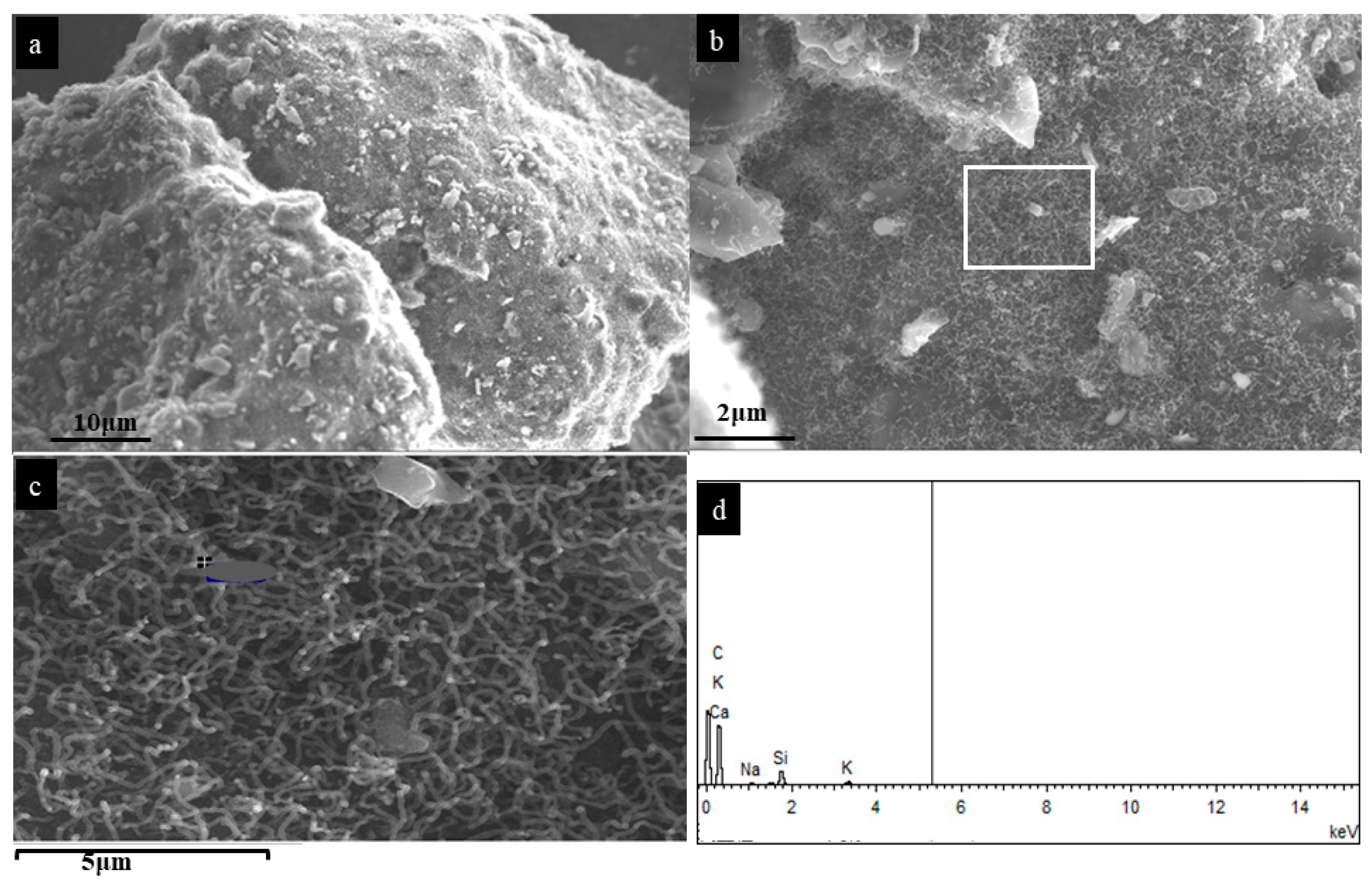

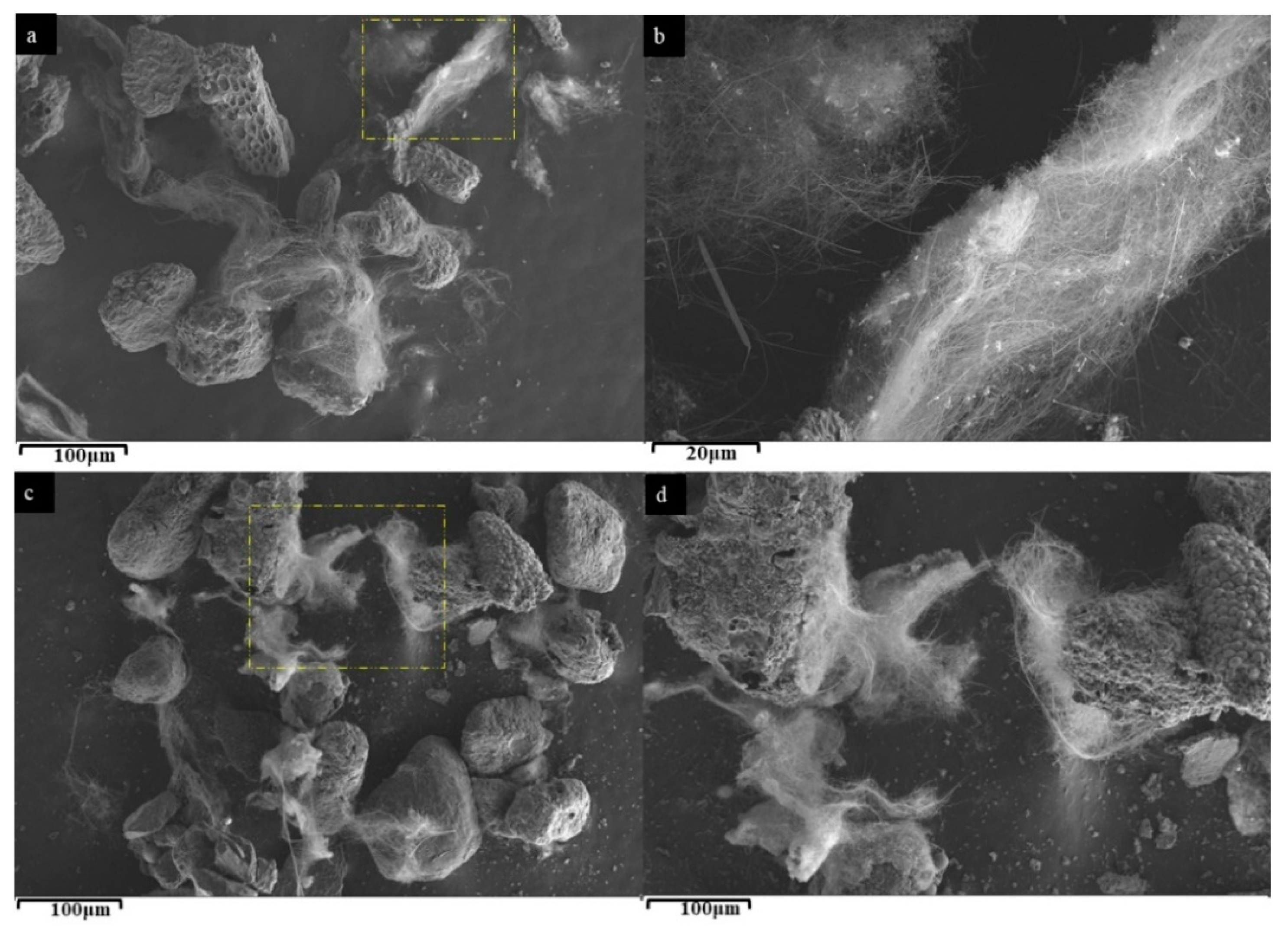

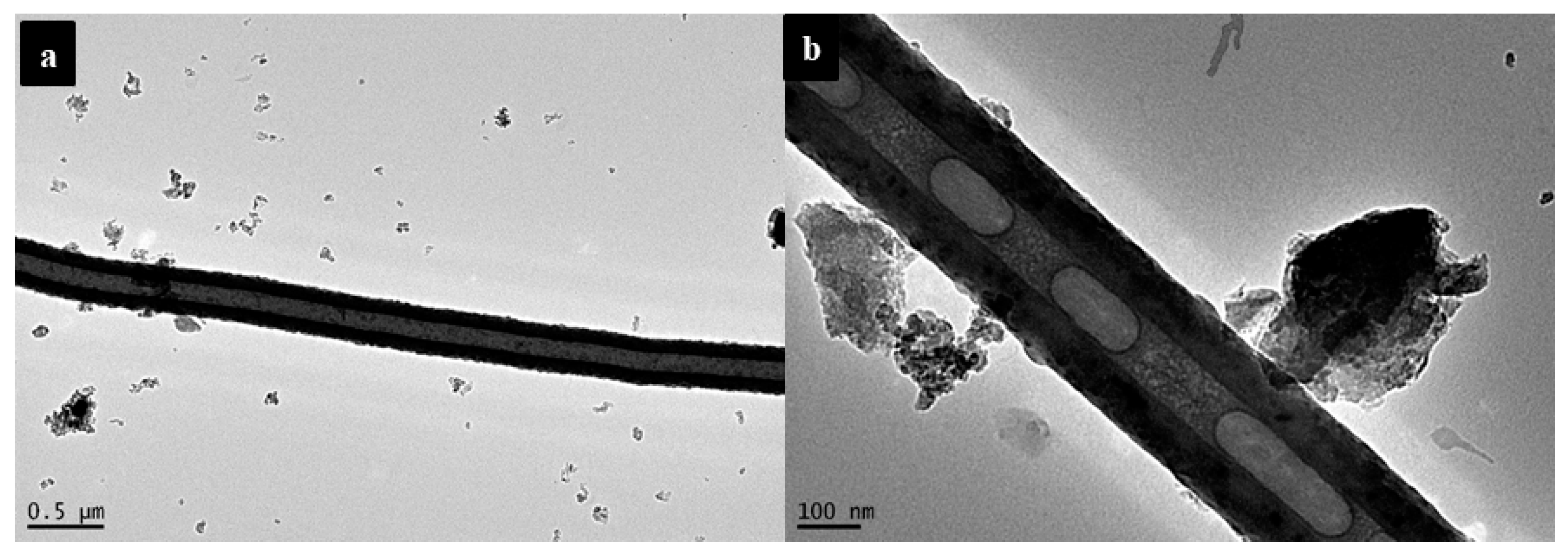
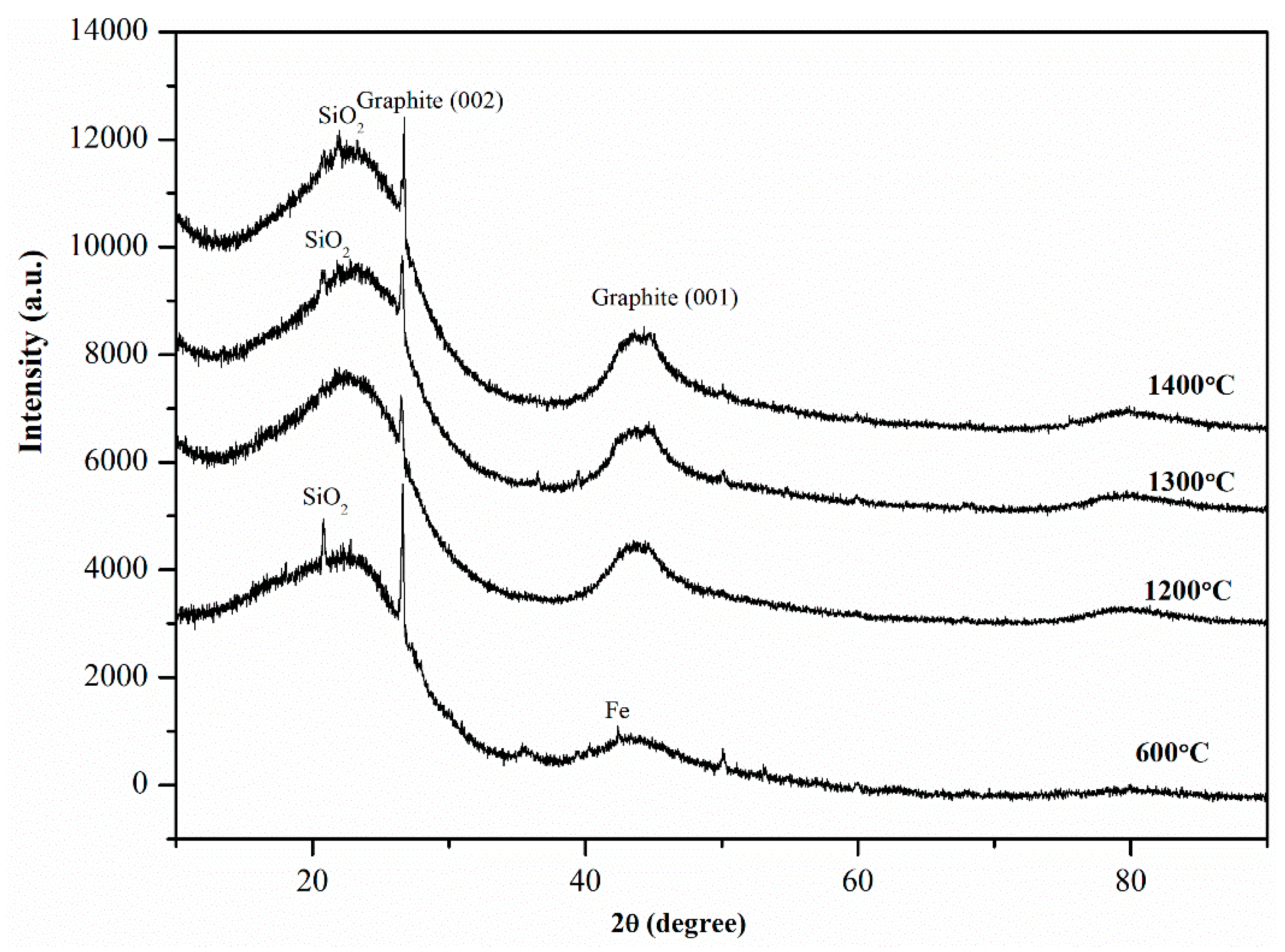
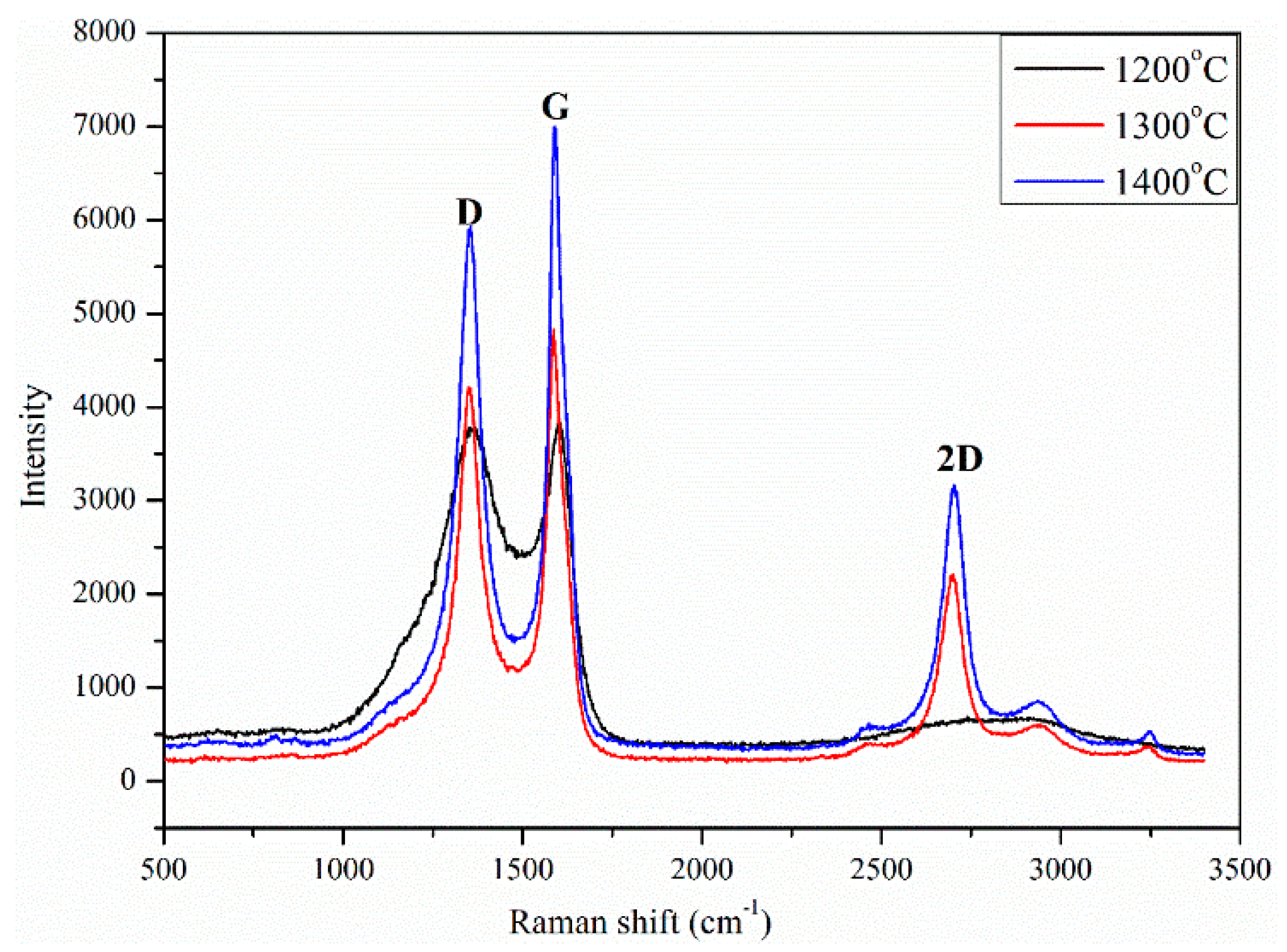
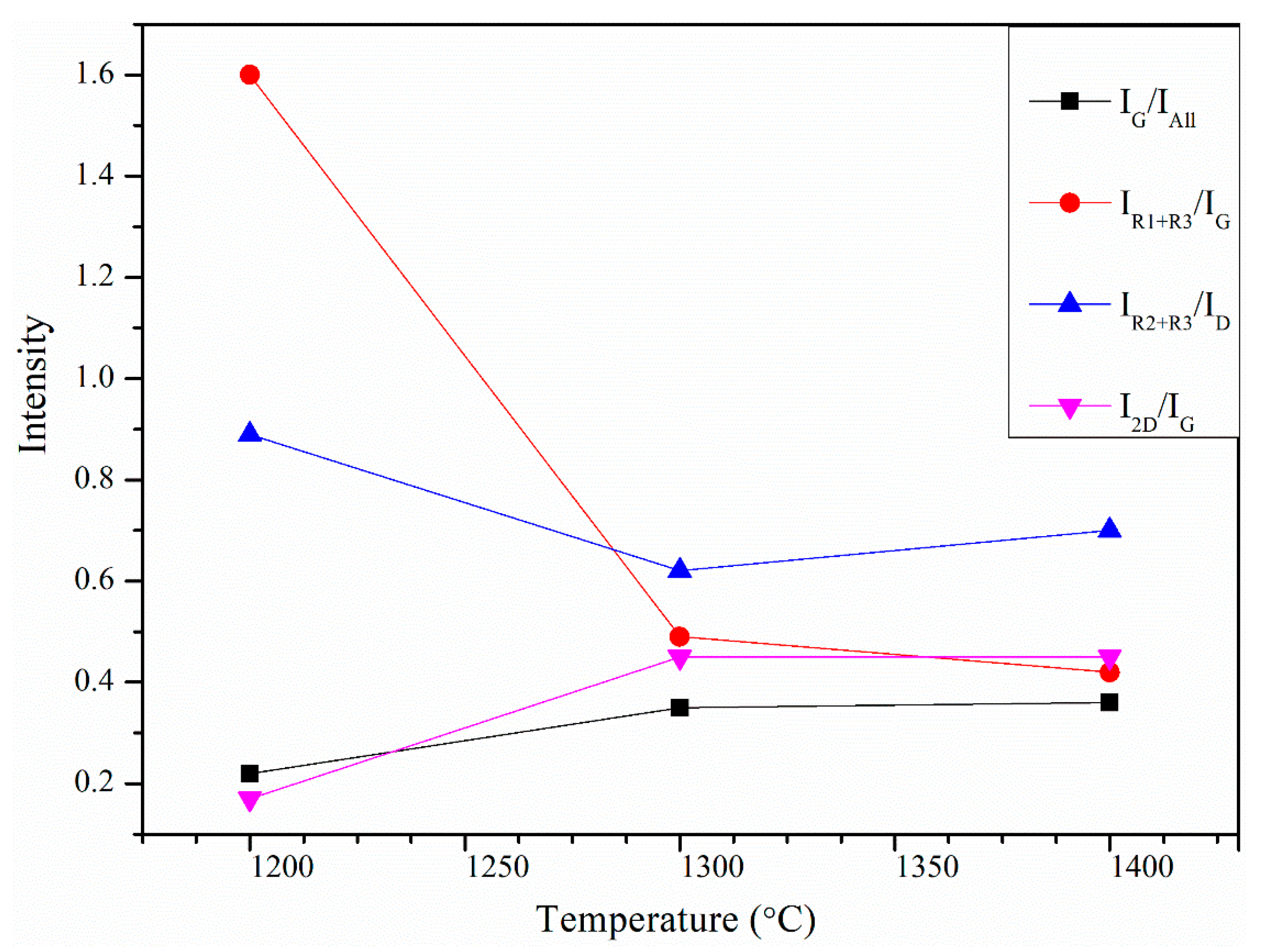
| Biomass Element | Weight (%) |
|---|---|
| Mg | 1.80 |
| Al | 3.95 |
| Si | 72.10 |
| P | 0.50 |
| K | 2.10 |
| Ca | 3.60 |
| Fe | 11.62 |
| Mean | StdDev | Min | Max | Length (mm) |
|---|---|---|---|---|
| 87.82 | 36.55 | 40.08 | 194.35 | 1.06 |
| 93.29 | 30.42 | 46.14 | 183.45 | 0.77 |
| 79.10 | 23.81 | 41.00 | 180.00 | 1.27 |
| 89.94 | 37.62 | 33.26 | 226.56 | 0.91 |
| 79.65 | 42.55 | 30.49 | 255.00 | 1.80 |
| 70.34 | 39.25 | 29.13 | 252.49 | 2.23 |
| Temperature (°C) | Area Proportion | ||||
|---|---|---|---|---|---|
| R1 | D | R3 | R2 | G | |
| 1200 | 0.23 | 0.35 | 0.23 | 0.06 | 0.11 |
| 1300 | 0.17 | 0.32 | 0.20 | 0.08 | 0.18 |
| 1400 | 0.18 | 0.30 | 0.22 | 0.08 | 0.20 |
| Synthesis Process/Parameters | Synthesized SL-CNTs in This Study | SL-CNTs Synthesized from Other Methods |
|---|---|---|
| Carbon source | Volatiles in biomass | Gases derived from fossil fuels (methane, ethane, acetylene, etc.) |
| Catalyst | No catalyst | metallic catalysts (Ni, Mo, Fe, Co, etc.) |
| Process | Microwave synthesis | Laser ablation, Arc discharge, CVD, CCVD, PECVD |
| Temperature | 600–1400 °C | 700–2500 °C |
| Time | 30 min | Ranges from 1–10 h |
| Length (mm) | 0.7–2 | 1–5 |
| Morphology | Ordered carbon structure with some defect | Ordered carbon structure with some defect |
Publisher’s Note: MDPI stays neutral with regard to jurisdictional claims in published maps and institutional affiliations. |
© 2022 by the authors. Licensee MDPI, Basel, Switzerland. This article is an open access article distributed under the terms and conditions of the Creative Commons Attribution (CC BY) license (https://creativecommons.org/licenses/by/4.0/).
Share and Cite
Esohe Omoriyekomwan, J.; Tahmasebi, A.; Zhang, J.; Yu, J. Synthesis of Super-Long Carbon Nanotubes from Cellulosic Biomass under Microwave Radiation. Nanomaterials 2022, 12, 737. https://doi.org/10.3390/nano12050737
Esohe Omoriyekomwan J, Tahmasebi A, Zhang J, Yu J. Synthesis of Super-Long Carbon Nanotubes from Cellulosic Biomass under Microwave Radiation. Nanomaterials. 2022; 12(5):737. https://doi.org/10.3390/nano12050737
Chicago/Turabian StyleEsohe Omoriyekomwan, Joy, Arash Tahmasebi, Jian Zhang, and Jianglong Yu. 2022. "Synthesis of Super-Long Carbon Nanotubes from Cellulosic Biomass under Microwave Radiation" Nanomaterials 12, no. 5: 737. https://doi.org/10.3390/nano12050737
APA StyleEsohe Omoriyekomwan, J., Tahmasebi, A., Zhang, J., & Yu, J. (2022). Synthesis of Super-Long Carbon Nanotubes from Cellulosic Biomass under Microwave Radiation. Nanomaterials, 12(5), 737. https://doi.org/10.3390/nano12050737






